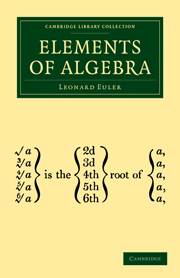Book contents
- Frontmatter
- ADVERTISEMENT
- MEMOIR OF THE LIFE AND CHARACTER OF EULER, BY THE LATE FRANCIS HORNER, ESQ., M. P.
- ADVERTISEMENT BY THE EDITORS OF THE ORIGINAL, IN GERMAN
- ADVERTISEMENT BY M. BERNOULLI, THE FRENCH TRANSLATOR
- Contents
- PART I Containing the Analysis of Determinate Quantities
- SECTION I Of the Different Methods of calculating Simple Quantities
- Chap. I OF Mathematics in general
- Chap. II Explanation of the signs + plus and − minus
- Chap. III Of the Multiplication of Simple Quantities
- Chap. IV Of the nature of whole Numbers, or Integers with respect to their Factors
- Chap. V Of the Division of Simple Quantities
- Chap. VI Of the properties of Integers, with respect to their Divisors
- Chap. VII Of Fractions in general
- Chap. VIII Of the Properties of Fractions
- Chap. IX Of the Addition and Subtraction of Fractions
- Chap. X Of the Multiplication and Division of Fractions
- Chap. XI Of Square Numbers
- Chap. XII Of Square Roots, and of Irrational Numbers resulting from them
- Chap. XIII Of Impossible, or Imaginary Quantities, which arise from the same source
- Chap. XIV Of Cubic Numbers
- Chap. XV Of Cube Roots, and of Irrational Numbers resulting from them
- Chap. XVI Of Powers in general
- Chap. XVII Of the Calculation of Powers
- Chap. XVIII Of Roots with relation to Powers in general
- Chap. XIX Of the Method of representing Irrational Numbers by Fractional Exponents
- Chap. XX Of the different Methods of Calculation, and of their Mutual Connexion
- Chap. XXI Of Logarithms in general
- Chap. XXII Of the Logarithmic Tables that are now in use
- Chap. XXIII Of the Method of expressing Logarithms
- SECTION II Of the different Methods of calculating Compound Quantities
- SECTION III Of Ratios and Proportions
- SECTION IV Of Algebraic Equations, and of the Resolution of those Equations
- PART II Containing the Analysis of Indeterminate Quantities
- ADDITIONS BY M. DE LA GRANGE
Chap. XXI - Of Logarithms in general
Published online by Cambridge University Press: 05 July 2011
- Frontmatter
- ADVERTISEMENT
- MEMOIR OF THE LIFE AND CHARACTER OF EULER, BY THE LATE FRANCIS HORNER, ESQ., M. P.
- ADVERTISEMENT BY THE EDITORS OF THE ORIGINAL, IN GERMAN
- ADVERTISEMENT BY M. BERNOULLI, THE FRENCH TRANSLATOR
- Contents
- PART I Containing the Analysis of Determinate Quantities
- SECTION I Of the Different Methods of calculating Simple Quantities
- Chap. I OF Mathematics in general
- Chap. II Explanation of the signs + plus and − minus
- Chap. III Of the Multiplication of Simple Quantities
- Chap. IV Of the nature of whole Numbers, or Integers with respect to their Factors
- Chap. V Of the Division of Simple Quantities
- Chap. VI Of the properties of Integers, with respect to their Divisors
- Chap. VII Of Fractions in general
- Chap. VIII Of the Properties of Fractions
- Chap. IX Of the Addition and Subtraction of Fractions
- Chap. X Of the Multiplication and Division of Fractions
- Chap. XI Of Square Numbers
- Chap. XII Of Square Roots, and of Irrational Numbers resulting from them
- Chap. XIII Of Impossible, or Imaginary Quantities, which arise from the same source
- Chap. XIV Of Cubic Numbers
- Chap. XV Of Cube Roots, and of Irrational Numbers resulting from them
- Chap. XVI Of Powers in general
- Chap. XVII Of the Calculation of Powers
- Chap. XVIII Of Roots with relation to Powers in general
- Chap. XIX Of the Method of representing Irrational Numbers by Fractional Exponents
- Chap. XX Of the different Methods of Calculation, and of their Mutual Connexion
- Chap. XXI Of Logarithms in general
- Chap. XXII Of the Logarithmic Tables that are now in use
- Chap. XXIII Of the Method of expressing Logarithms
- SECTION II Of the different Methods of calculating Compound Quantities
- SECTION III Of Ratios and Proportions
- SECTION IV Of Algebraic Equations, and of the Resolution of those Equations
- PART II Containing the Analysis of Indeterminate Quantities
- ADDITIONS BY M. DE LA GRANGE
Summary
220. Resuming the equation ab = c, we shall begin by remarking that, in the doctrine of Logarithms, we assume for the root a, a certain number taken at pleasure, and suppose this root to preserve invariably its assumed value. This being laid down, we take the exponent b such, that the power ab becomes equal to a given number c; in which case this exponent b is said to be the logarithm of the number c. To express this, we shall use the letter L. or the initial letters log. Thus, by b = L. c, or b = log. c, we mean that b is equal to the logarithm of the number c, or that the logarithm of c is b.
221. We see then, that the value of the root a being once established, the logarithm of any number, c, is nothing more than the exponent of that power of a, which is equal to c: so that c being = ab, b is the logarithm of the power ab. If, for the present, we suppose b = 1, we have 1 for the logarithm of a1, and consequently log. a = 1; but if we suppose b = 2, we have 2 for the logarithm of a2; that is to say, log. a2 = 2, and we may, in the same manner, obtain log. a3 = 3; log. a4 = 4; log. a5 = 5, and so on.
- Type
- Chapter
- Information
- Elements of Algebra , pp. 63 - 66Publisher: Cambridge University PressPrint publication year: 2009First published in: 1822

